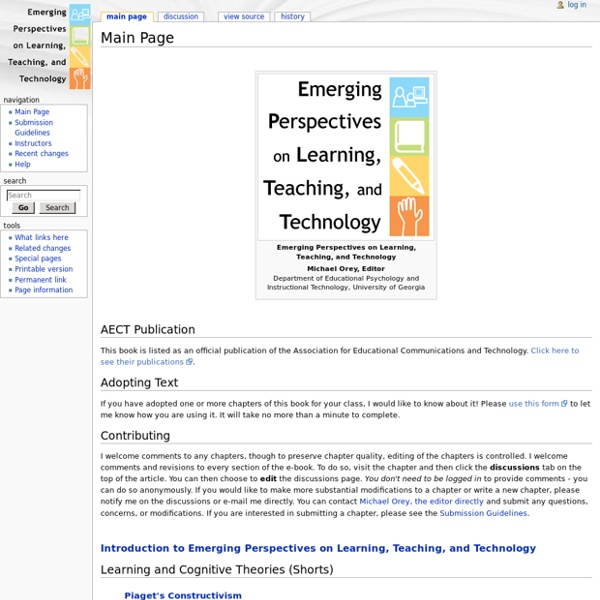



http://epltt.coe.uga.edu/index.php?title=Main_Page
Related: LEARNINGInformation processing Michael Orey Department of Educational Psychology and Instructional Technology, University of Georgia Review of Information Processing Introduction Figure 1. The Inspiration web above shows how Information Processing can be likened to the model of a computer. An Introduction to Connective Knowledge ~ Stephen's Web ~ b You are not logged in. [] [] Revised and Updated (minor corrections and typos only) and placed in MS-Word Document form, November 27, 2007. Click here . The version that follows below is the original (uncorrected) version). Yet another article, describing new forms of knowledge as probablistic , has crossed my desk today, and consequently it seems appropriate at this time to type a few words on the nature of distributed knowledge.
Framework for 21st Century Learning The Framework presents a holistic view of 21st century teaching and learning that combines a discrete focus on 21st century student outcomes (a blending of specific skills, content knowledge, expertise and literacies) with innovative support systems to help students master the multi-dimensional abilities required of them in the 21st century and beyond. The key elements of 21st century learning are represented in the graphic and descriptions below. The graphic represents both 21st century student outcomes (as represented by the arches of the rainbow) and 21st century learning support systems (as represented by the pools at the bottom). Nine events of instruction 1 Definition "Nine events of instruction" is an instructional design model put together by Gagne. This is a behaviorist model that also draws from cognitivism. 2 The conditions of learning “Essential to Gagne's ideas of instruction are what he calls "conditions of learning." He breaks these down into internal and external conditions.
elearnspace. everything elearning. Why Curation Will Transform Education and Learning: 10 Key Reasons There is a growing number of key trends that are both rapidly revolutionizing the world of education as we know it and opening up opportunities to review and upgrade the role and scope of many of its existing institutions, (as the likeliness that they are going to soon become obsolete and unsustainable, is right in front of anyone's eyes). George Siemens, in his recent Open Letter to Canadian Universities, sums them up well: 1) An Overwhelming Abundance of Information Which Begs To Be OrganizedThe goal is not (and probably it never was) to learn or memorize all of the information available out there.
Presentations – M David Merrill If your organization would like to schedule a live or online presentation or discussion with Dr. Merrill please contact him to arrange time, place, and content of the lecture. Online Mentored Workshop: Designing Interactive Instructional Templates. 19 short video lessons. Future of Education: Breaking The Connection Between Learning and Assessment - Epic 2020 It is the best of times. It is the worst of times. Let's find out. Sal Khan The road to 2020 began in 2009. First Principles of Instruction – M David Merrill Merrill, M. D. (2002). First Principles of Instruction. Educational Technology Research and Development. 50(3), 43-59. Merrill, M. Educating Players: Are Games the Future of Education? CAMBRIDGE, Mass.—Smart phones, tablets and video game systems are often seen as distractions to school children in developed countries, which tend to adhere to a strict teacher-student educational model. At Technology Review‘s Emerging Technologies (EmTech) conference here on October 25, a panel of technologists and educators posited that it’s time to embrace students’ use of such technologies and rethink learning in both developed and developing countries. “The issue isn’t education or schools—it’s learning,” panelist Nicholas Negroponte, founder and chairman emeritus of M.I.T.’s Media Lab and the chairman of the One Laptop Per Child (OLPC) foundation, said.
Media and Information Literacy People across the world are witnessing a dramatic increase in access to information and communication. While some people are starved for information, others are flooded with print, broadcast and digital content. Media and Information Literacy (MIL) provides answers to the questions that we all ask ourselves at some point. How can we access, search, critically assess, use and contribute content wisely, both online and offline? What are our rights online and offline? What are the ethical issues surrounding the access and use of information? Exploring a New Paradigm in human capital development, driven by accelerating change. Introduction to Bloom’s Taxonomy – Niall McNulty Benjamin Bloom: the man who changed education Get the Bloom’s Digital Taxonomy guide from Amazon. This e-book is a practical guide for teachers on how to use Bloom’s taxonomy in a digital classroom setting. An introduction is provided to the Bloom’s taxonomy framework and its adaption for use in a digital environment, with each level discussed and a digital activity suggested that teachers could use with their students. Benjamin Samuel Bloom (February 21, 1913 – September 13, 1999) was an American educational psychologist who examined and then restructured the way teaching should be approached, to maximise learners’ performance.